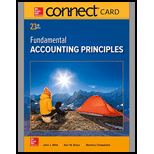
1)
Introduction:
Cost of Goods Sold:
• Cost of goods manufactured is the total cost of producing goods that are later sold to realize revenues. It includes direct and indirect materials, labor and
• Cost of Goods sold is used to compute the cost of producing goods and selling goods for a particular period.
• Cost of Goods sold comprises of Cost of Materials, Labor and Overhead attributable to goods manufactured i.e. Cost of Goods Manufactured as well as selling and distribution costs such as shipping and handling expenses.
Contingent expenses and
• These are expenses and liabilities that are conditional in nature and their future occurrence is conditional on the happening or not happening of certain events.
• An example of this category of expense and liability are warranties. Warranty expenses and warranty liability refer to the costs of repairing defect products that have been sold and are in the warranty period.
• Every sold finished good comes with a warranty. A warranty can be invoked when the product is defective and there is no fault of the consumer. Warranty costs are recorded as estimates based on studies and past trends in the financial statements.
To Determine:
Why shipping, handling and warranty expenses are included in the cost of goods sold.
2)
Introduction:
Effect of costs on Profits
• Profitability analysis takes place after costs have been allocated and bifurcated into direct and indirect costs.
• Direct costs are costs directly attributable to cost of goods sold such as material, labor and overheads. Indirect costs are costs indirectly attributable to cost of goods sold such as selling and distribution expenses.
• Inclusion of items such as of shipping, handling and warranty expenses in the cost of goods sold leads to reduced profitability and has an adverse impact on ratio analysis of financial statements.
Ratio Analysis
• Ratio analysis is a study of several key metrics of a company based on the data presented in its’ financial statements with an objective to evaluate the financial health of a company.
• It is essential for investors, stakeholders, government bodies etc. to evaluate the key metrics of an entity in order to ensure that the company fulfills the going concern principle and displays financial stability.
• Examples of Ratios for analysis of financial statements includes Net profit Margin Ratio, Asset Turnover ratio etc.
To Determine:
Effect of inclusion of items such as of shipping, handling and warranty expenses in the cost of goods sold and analysis of financial statements.
3)
Introduction:
Cost of Goods Sold:
• Cost of goods manufactured is the total cost of producing goods that are later sold to realize revenues. It includes direct and indirect materials, labor and overhead.
• Cost of Goods sold is used to compute the cost of producing goods and selling goods for a particular period.
• Cost of Goods sold comprises of Cost of Materials, Labor and Overhead attributable to goods manufactured i.e. Cost of Goods Manufactured as well as selling and distribution costs such as shipping and handling expenses.
Contingent expenses and contingent liabilities
• These are expenses and liabilities that are conditional in nature and their future occurrence is conditional on the happening or not happening of certain events.
• An example of this category of expense and liability are warranties. Warranty expenses and warranty liability refer to the costs of repairing defect products that have been sold and are in the warranty period.
• Every sold finished good comes with a warranty. A warranty can be invoked when the product is defective and there is no fault of the consumer. Warranty costs are recorded as estimates based on studies and past trends in the financial statements.
To Determine:
If policy with respect to costs included in cost of sales have changed.
Want to see the full answer?
Check out a sample textbook solution
Chapter 20 Solutions
Connect Access Card for Fundamental Accounting Principles
- Expert need your helparrow_forwardI need assistance with this financial accounting question using appropriate principles.arrow_forwardHorngren's Financial & Managerial Accounting: The Managerial Chapters, 8th Edition. E-M:9-16 Using responsibility reports to evaluate cost, revenue, and profit centers The accountant for a subunit of Bellamy Sports Company went on vacation before completing the subunit’s monthly responsibility report. This is as far as she got: Subunit X Revenue by Product Actual Results Flexible Budget Variance F or U Flexible Budget Sales Volume Variance F or U Static Budget Downhill-RI $ 326,000 (a) (b) $ 19,000 F $ 301,000 Downhill-RII $ 154,000 (c) $ 164,000 (d) $ 148,000 Cross-EXI $ 280,000 $ 1,000 U $ 281,000 (e) $ 297,000 Cross-EXII $ 254,000 (f) $ 249,000 $ 16,500 U $ 265,500 Snow-LXI $ 424,000 $ 2,000 F (g) (h) $…arrow_forward
- Can you explain the process for solving this financial accounting problem using valid standards?arrow_forwardI need guidance with this general accounting problem using the right accounting principles.arrow_forwardI am trying to find the accurate solution to this general accounting problem with appropriate explanations.arrow_forward

 AccountingAccountingISBN:9781337272094Author:WARREN, Carl S., Reeve, James M., Duchac, Jonathan E.Publisher:Cengage Learning,
AccountingAccountingISBN:9781337272094Author:WARREN, Carl S., Reeve, James M., Duchac, Jonathan E.Publisher:Cengage Learning, Accounting Information SystemsAccountingISBN:9781337619202Author:Hall, James A.Publisher:Cengage Learning,
Accounting Information SystemsAccountingISBN:9781337619202Author:Hall, James A.Publisher:Cengage Learning, Horngren's Cost Accounting: A Managerial Emphasis...AccountingISBN:9780134475585Author:Srikant M. Datar, Madhav V. RajanPublisher:PEARSON
Horngren's Cost Accounting: A Managerial Emphasis...AccountingISBN:9780134475585Author:Srikant M. Datar, Madhav V. RajanPublisher:PEARSON Intermediate AccountingAccountingISBN:9781259722660Author:J. David Spiceland, Mark W. Nelson, Wayne M ThomasPublisher:McGraw-Hill Education
Intermediate AccountingAccountingISBN:9781259722660Author:J. David Spiceland, Mark W. Nelson, Wayne M ThomasPublisher:McGraw-Hill Education Financial and Managerial AccountingAccountingISBN:9781259726705Author:John J Wild, Ken W. Shaw, Barbara Chiappetta Fundamental Accounting PrinciplesPublisher:McGraw-Hill Education
Financial and Managerial AccountingAccountingISBN:9781259726705Author:John J Wild, Ken W. Shaw, Barbara Chiappetta Fundamental Accounting PrinciplesPublisher:McGraw-Hill Education





